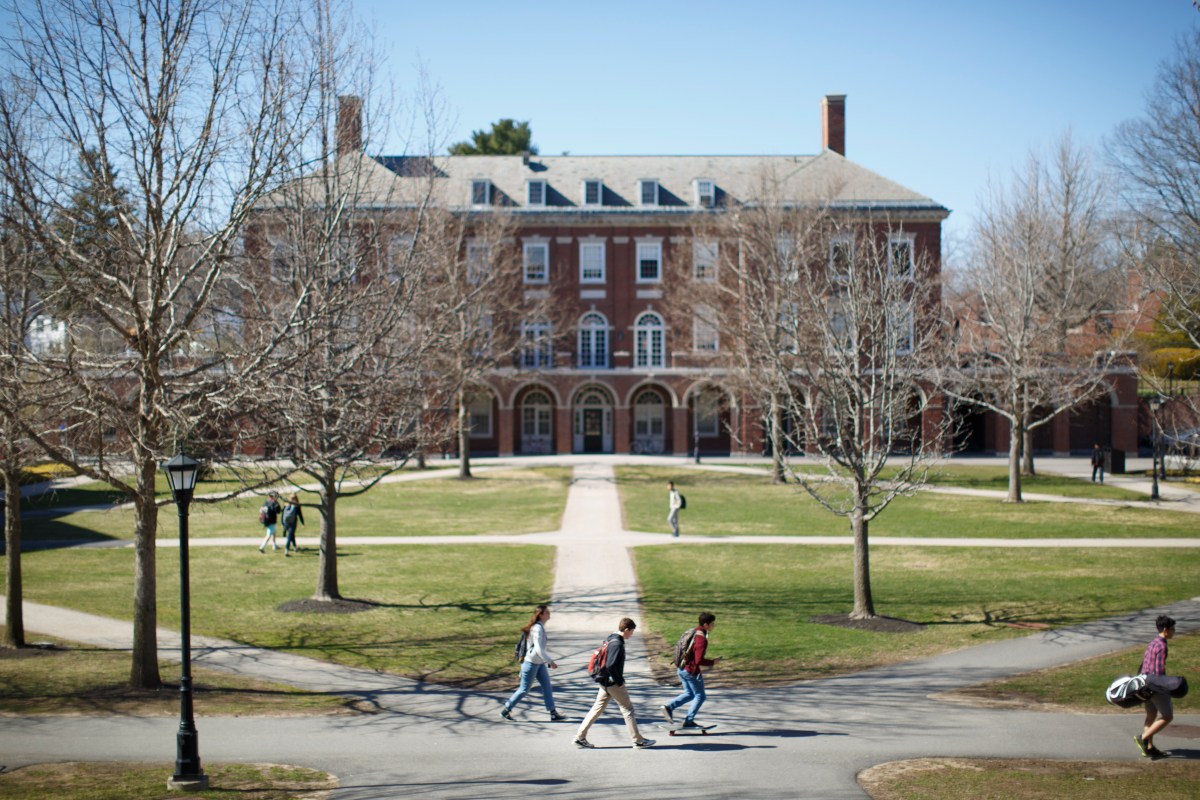If you think of institutions as organisms, you can gain a clearer understanding of how they function. When confronting an existential crisis, institutions, like all living things, reach a Darwinian crossroads: evolve or die. In the educational ecosystem, boarding schools are a particularly striking species. With an average cost of $56,875 per year, these elite residential high schools are more expensive than most private colleges.
While this prohibitive price tag does little to assuage the stigmas some skeptics associate with boarding schools — namely that they are elitist establishments that preserve white privilege, nurture entitlement, and condone pastel khakis as acceptable wardrobe choices — such dismissive criticism overlooks the inherent value of a boarding-school education. The reason boarding schools cost more than most colleges is because they offer more: more services and more opportunities, a value proposition that this Forbes op-ed trumpets. Boarding-school amenities and facilities rival those of college campuses, but they provide a level of tailored support within a strong community that even the most well-funded universities cannot offer.
But what happens when that physical community disappears? What happens when you take the “boarding” out of a boarding school? Like all educational institutions, boarding schools had to abruptly reinvent themselves when the coronavirus besieged society. Unlike other breeds of school, though, they had to do so without their singularly defining characteristic.
“The one thing that makes us different is that we live where we learn and teach,” says Drew Casertano, the headmaster of Millbrook School, a coeducational school nestled in the heart of the Hudson Valley. “It’s not academic excellence. There are day schools with academic excellence. There are public schools with academic excellence. But they don’t teach values and build culture through being together 24/7 in a community. And last spring, we couldn’t do that. We had to figure out how to do it remotely.”
Mr. Casertano has served as Millbrook’s head for 30 years, an unprecedented tenure in an industry where the average headship is in the single digits. He is widely revered within the boarding-school world, having previously served as the president of the Headmasters Association. In other words, he’s the leader that other school leaders call when they need help.
Based on anecdotal feedback and school-conducted surveys, most boarding schools delivered a satisfactory remote program last spring. With small class sizes, the average boarding school Zoom room was an animated environment as opposed to a faceless wall of black tiles. Dorm parents hosted regular meetings, coaches stayed connected with athletes and faculty devised innovative ways to maintain and build community from a distance. Given the sudden paradigm shift as well as unsettling reports of how badly many public-school systems had bungled remote learning, students and their parents were generally satisfied with their experience. Nevertheless, the crisis has raised questions about boarding-school economics and the future of the industry.
For starters, would schools reimburse families for services paid for but not rendered, such as room and board? Yes. Kind of. Many boarding schools offered a spring tuition credit between $2,000 and $4,000 (a ballpark figure for room and board is between $6,000 and $8,000 per semester). The gesture, more symbolic than substantive, appeased most families and dissuaded the widespread ire (and lawsuits) that colleges faced. In fact, several headmasters have boasted that a large percentage of families returned the payment as a gift to their school’s annual fund.
A more pressing question the industry has had to address is what will boarding school look like next semester? For school leaders tasked with answering this question, tracking the medical developments and political responses to the pandemic has been like watching a weathervane in a hurricane. Nonetheless, most schools have unveiled tentative plans for September in recent weeks. Unlike higher education — where few colleges have announced plans to fully open their campus, prompting many students to transfer or pursue a gap year and consequently leaving a dangerous revenue crunch in their wake — almost every boarding school has declared its intention to open campus for the fall term.
“Colleges, by design, are highly porous communities whereas most boarding schools have one way of getting in and one way of getting out,” says Mr. Casertano. “There will be compromises, there will be different ways of doing things until we have a clearer picture medically. That said, the most important thing here, and this is what everyone from epidemiologists to educational theorists are saying, [is that] kids need to be in school. It will be damaging to our country if kids aren’t back in school.”
Based on the nine different reopening plans that InsideHook obtained, most schools are pursuing nearly identical strategies. Here are the common takeaways:
- Campus repopulation will be highly controlled and contingent on mandatory virus testing
- International students must adhere to CDC requirements for entering the country, including a 14-day quarantine before arriving on campus
- Remote learning will be offered to students who cannot return to campus (most, but not all, schools are offering discounted tuition for these students)
- Masks will be required in every building except dormitories, where state governors have ruled that dorm residents constitute a “family unit”
- Classrooms and other spaces will be modified to accommodate social distancing
- Access to and from campus will be highly restricted, including for parents and families
- Schools are unable to commit to fall athletic seasons at this date
- In the event of a spike in local covid-19 cases and/or state orders to close campus, families should be prepared for students to return home and engage in remote learning
- When students leave campus for Thanksgiving, they will stay at home and engage in a two-week remote learning program before returning to campus in January
While schools will be open come September, there is no denying that the boarding school experience will be radically different. As one school administrator said, social distancing is antithetical on campuses where every brick is designed to facilitate social interaction. But industry leaders like Mr. Casertano see the current moment as a chance for boarding schools to prove their value.
“One of the things we try to teach at boarding schools is that enjoying the benefits of a community requires compromise and sacrifice and commitment,” says Mr. Casertano. “There is going to be an opportunity to teach that even more next year.”
Can boarding schools survive coronavirus? Well, that depends on the school. Yes, probably, no. To understand why requires an awareness of how educational non-profits operate and the disparate hierarchy within the boarding-school world.
The table below is populated with real data from three boarding schools that represent the range of financial health and institutional stability within the industry.
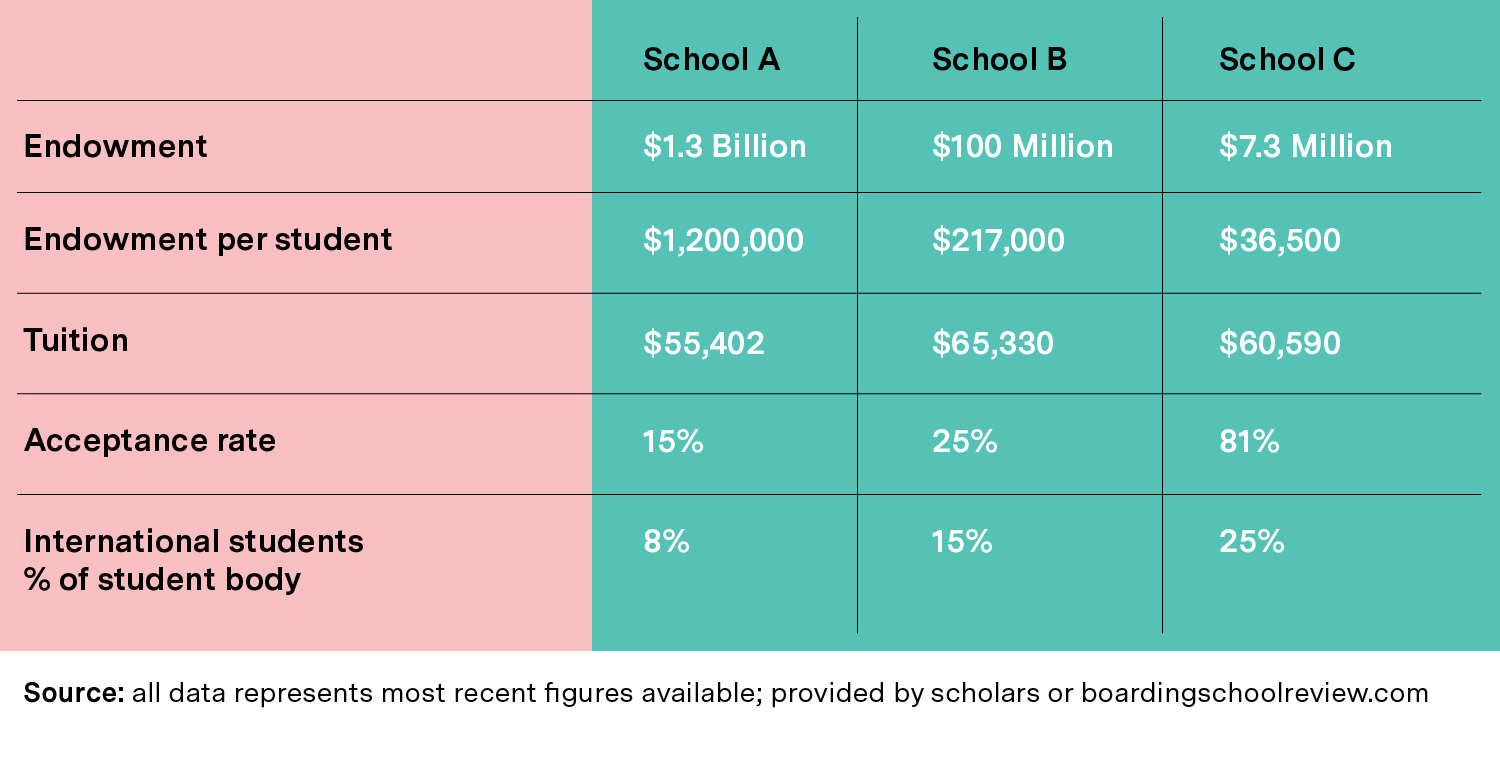
There are only a handful of schools like School A. They’re the Dwayne “The Rock” Johnsons of boarding school: indisputable A-listers that are beautiful, financially savvy and extremely well-endowed. School A and the six or seven other juggernauts that breathe the same rarefied air will only be stronger when the infectious coronavirus dust settles.
School B and its ilk are more equivocal. Of the 300+ boarding schools in the United States, a vast majority fall into this camp. They’re like a Mark Wahlberg character. There’s an audience for all of them, many of them are indistinguishable, and some of them are well-endowed but a bit misguided. As long as they play their cards right, they’ll survive coronavirus.
And then there are schools like School C. These are the Fredo Corleones of boarding school. Well-intentioned but desperate, neglected and irrevocably weak. Whenever the coronavirus movie ends, these schools, like Fredo, will be underwater.
The vital signs for boarding schools are not rocket science.
“It’s pretty simple,” says Mr. Casertano. “Without an endowment, you have no choices.”
Endowment per student is a more specific way to gauge an institution’s strength. The gold standard for boarding schools is $500,000 or higher, but anything north of $200,000 is considered seaworthy. The larger this figure, the more capital a school has to invest in itself and the less dependent it is on tuition for operating revenue; it’s not a coincidence that School A has the lowest tuition of the three. Furthermore, a high endowment per student insulates schools from tuition-threatening events — like, say, the sudden onset of a pandemic.
The charts below illustrate how the different schools generated revenue to cover their operating expenses in 2018. The power of School A’s endowment draw is staggering, as is the disparity in tuition weights. Note: endowment “draw” refers to the small percentage of the total endowment (typically < 5%) that a school withdraws to meet its budget each fiscal year.
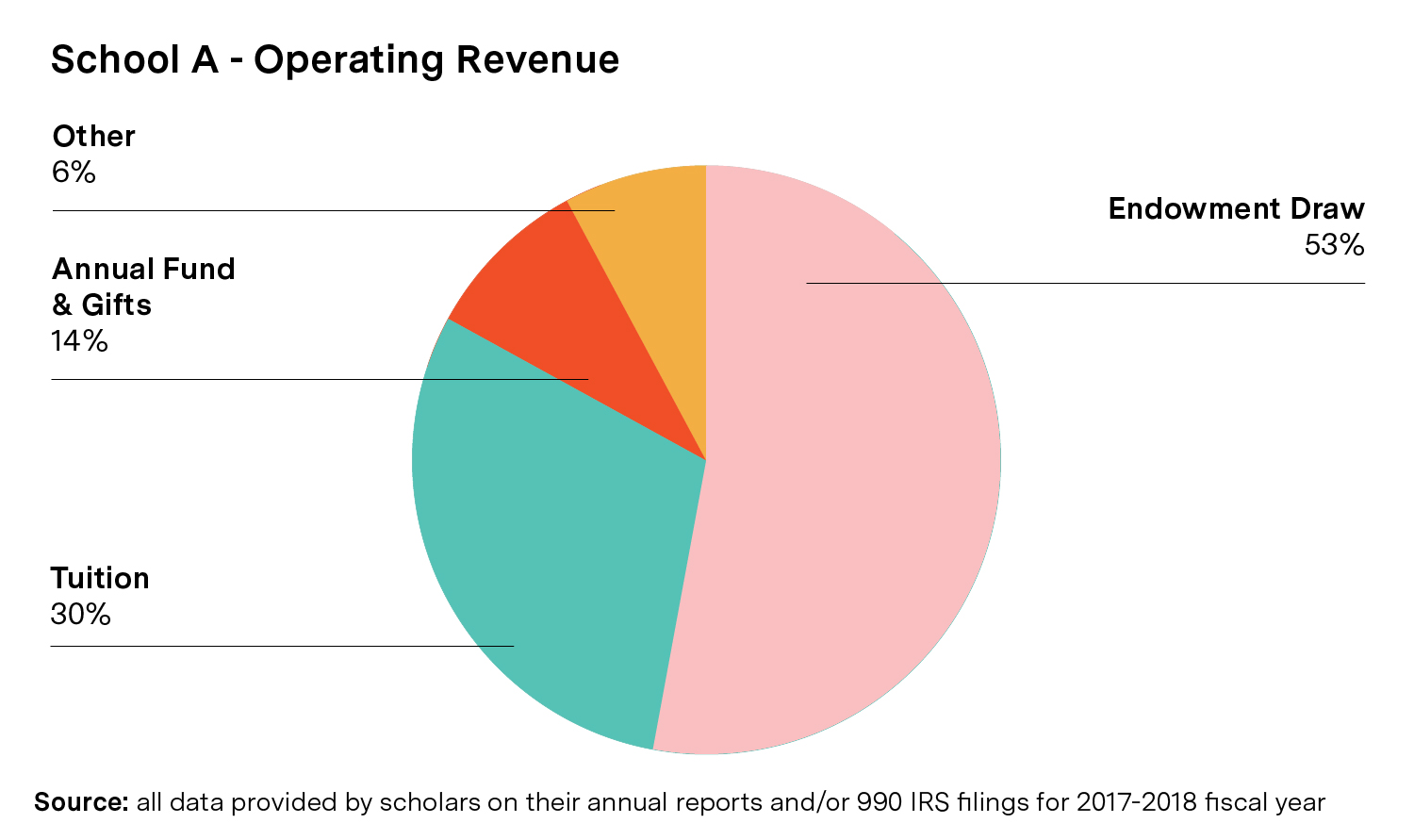
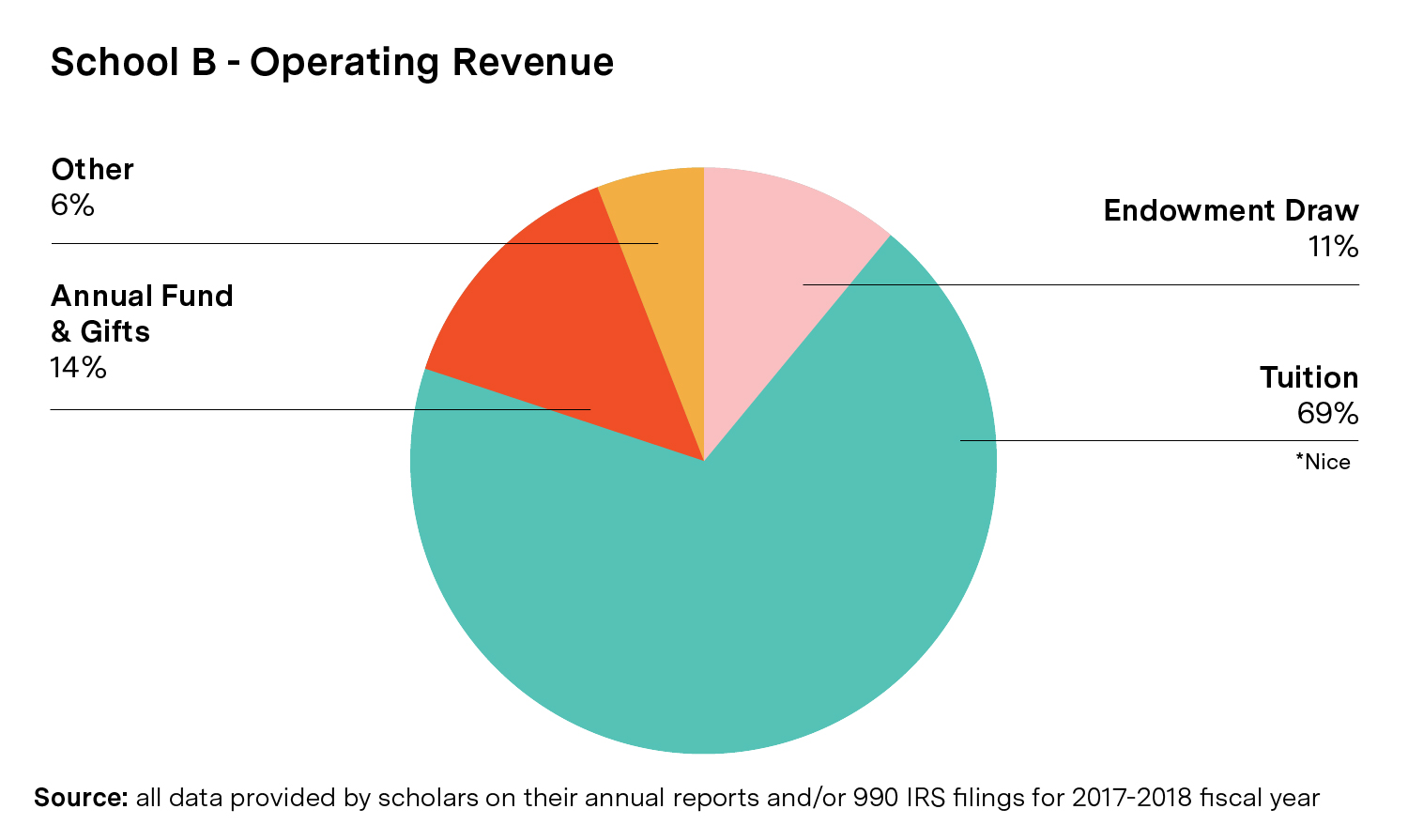
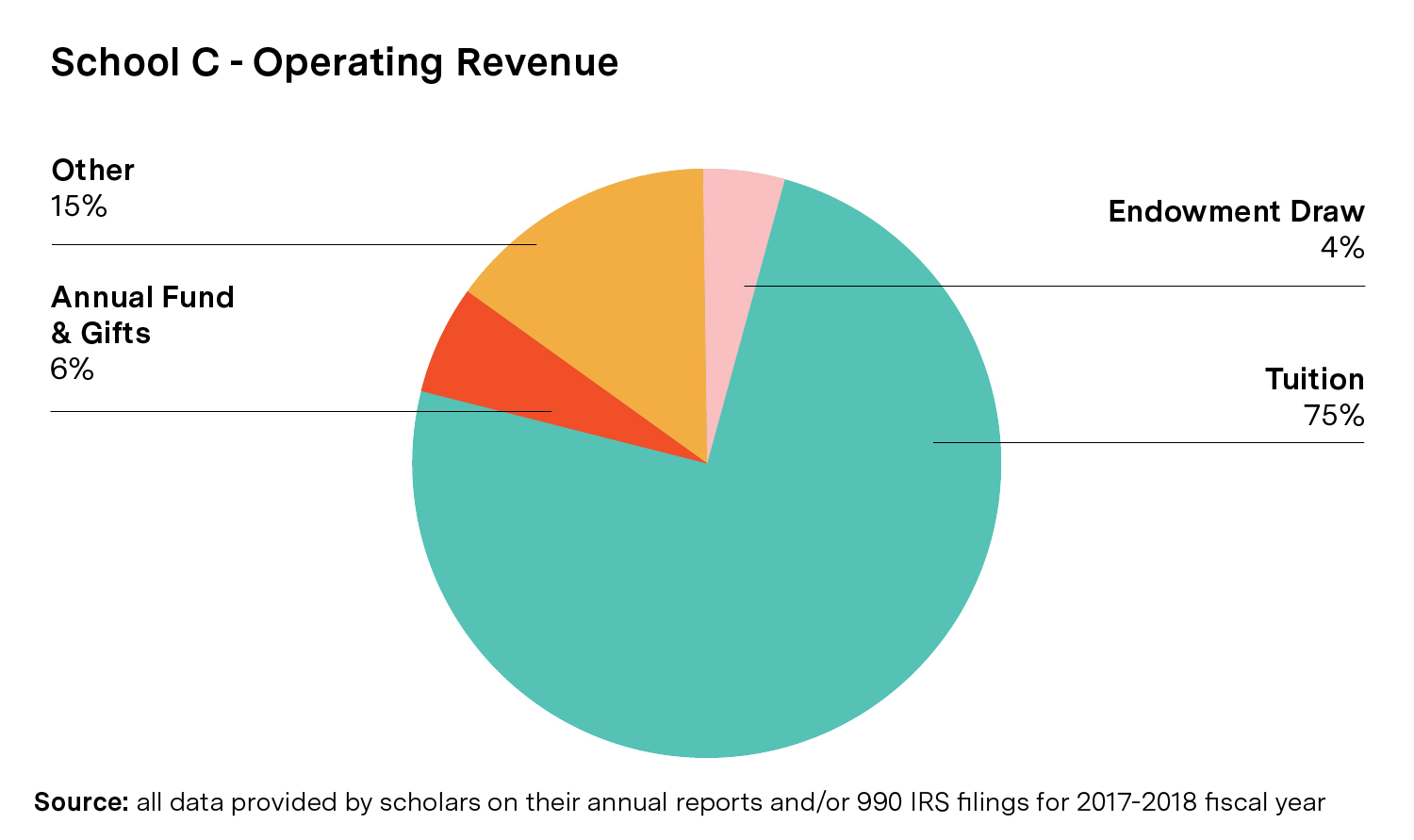
When it comes to endowment, size matters. Schools with massive endowments have more flexibility to construct or renovate buildings, recruit and retain faculty, create new academic departments, supplement tuition, fund extracurricular programs and do whatever else they deem necessary to fortify their position. For these institutions — schools like A and B above — a healthy endowment is akin to having a healthy trust fund. At the other end of the spectrum, School C’s endowment is like a checking account in swift decline. It can help pay the bills, but at the rate it’s being tapped, the lights won’t stay on forever.
Because tuition revenue is critical to every school’s operating model, admissions statistics speak volumes about a school’s health. Selectivity signals demand in the marketplace, especially when it comes to domestic students who can pay full tuition. According to Mr. Casertano, “That tells you how deep your pool is.” Most admissions directors are tight-lipped about this particular figure, but you can approximate it by looking at a school’s overall acceptance rate and the size of its international student population. We’ll explain.
Admissions offices at American boarding schools have a complicated attitude towards international students. On the one hand, they use them to market their institution’s diversity and they covet their financial contributions. (International students almost always pay full tuition plus an additional “international fee.”) That said, schools are wary of having too many international students. (There’s no consensus about how many is “too many,” but I’ve heard several admissions directors say that over 20% is high.) The resistance to large international populations boils down to two driving factors: perception and risk. To use economic parlance, a high international supply signals low domestic demand. This perception connotes financial instability, and with so many similar schools in the marketplace, it’s one of many factors that might persuade a family to shop elsewhere. While the line between perception and reality is not always straight, there are real risks to being too reliant on international students to fill your school. What happens if demand in a certain country suddenly dries up? What happens if a pandemic or xenophobic president (or both) closes the borders?
While the coronavirus will not be singularly responsible for shuttering weak boarding schools, it has exposed glaring vulnerabilities in how these schools operate. Leadership, as for all institutions, is the key. Mr. Casertano, at least, has been frustrated with the lack of discipline and vision he’s observed from leaders across his industry.
“This is all a governance problem. Boards of trustees have been asleep at the switch,” he says. “Most heads have no clue about admissions. They know nothing about it.” This ignorance of a central component of their business models has caused several heads to lead their schools down a dangerous path by pursuing a revenue strategy known as the net tuition revenue model. “That’s a death spiral,” Mr. Casertano tells us.
The net tuition revenue model works like this: when an admissions office cannot yield the number of full-pay domestic students it needs to meet its budget, it discounts its tuition in order to fill its beds. “Now you have less tuition revenue,” explains Mr. Casertano, “So you’re basically running your admissions program like an airline. Sell every seat for what you can get. Your admissions director has no ability to make markets, the head is clueless, and the board just watches.” This is how schools like School C have functioned for several years.
Mr. Casertano’s outlook for boarding schools as a whole is bullish. “There will be a contraction in the market, but strong schools — the top-tier, heavily resourced schools — will come out stronger than ever.” That is why Mr. Casertano and like-minded heads have been pounding the pavement and fundraising throughout the pandemic. Deep coffers increase an institution’s ability to control its destiny and bolster its capacity to weather any kind of storm.
To weather the coronavirus storm, many boarding schools applied for federal Paycheck Protection Program (PPP) loans last spring. While the wealthiest schools withdrew their applications amid public outcry, schools with smaller endowments felt compelled to accept the loans in order to avoid firing teachers and staff. On Monday, the Small Business Administration disclosed the names of all businesses that received PPP loans. The private schools that accepted public funds were met with swift scrutiny, and the media coverage has done little to separate the balance sheets of these non-profit institutions from their affluent clientele. Some might call that unfair. Others might say defending these schools is like playing the world’s smallest violin.
Looming beyond this controversy is a much graver problem. In the wake of George Floyd’s murder and widespread protests over racial inequality, students and alumni have demanded that boarding schools do their part to address institutional racism. Almost every boarding school issued a statement in late May expressing its commitment to this cause and its support of Black Lives Matter. The key test will be how many schools back up this pledge with dollars. Only the most privileged institutions will have the resources to meaningfully confront their own privilege, thus consolidating their status as desirable institutions and widening the gap between the haves and the have … lesses.
This article was featured in the InsideHook newsletter. Sign up now.
